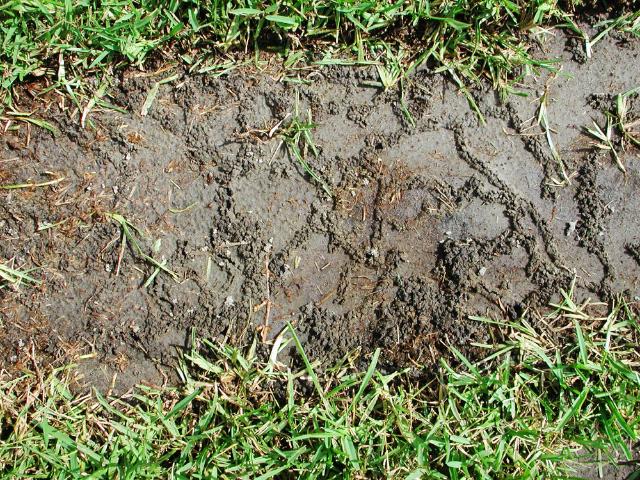
by Larry Williams | Apr 20, 2015
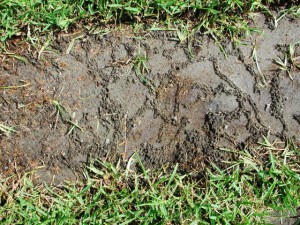
Mole cricket tunnels. Credit: N. Leppla, UF/IFAS
Many people treat their lawn with an insecticide when they see mole crickets in the spring or at the first sign of a brown area in their lawn. What they don’t understand is the biology of this pest.
Mole crickets spend the winter as adults in the soil. As temperatures warm in late February and March, adult mole crickets emerge and begin to mate. Male mole crickets construct a chamber in the soil and chirp to attract female crickets. Attracted females fly to the males. After mating, males die and females fly to a suitable area for egg laying. Mated females begin tunneling and laying eggs in the tunnels. They lay about four clutches of eggs in different areas, averaging 35 eggs per clutch. Female crickets die shortly after laying their eggs.
Use of insecticides during early spring is not recommended because:
- adult mole crickets are not easily killed
- they cause minimal lawn damage during the mating and egg laying process, and,
- reinfestation from subsequent flights is likely.
The best time to treat for mole crickets is during mid-June through July. This will be when eggs have hatched but before the nymphs (immature mole crickets) are large enough to do much damage. Proper timing of the insecticide application is very important to achieve control.
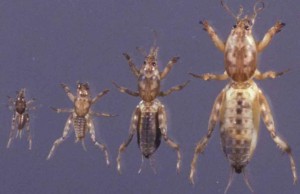
Mole cricket nymphs. Credit: J. Castner, UF/IFAS
If you are not sure if mole crickets are present, you can find out with a soap solution. Mix 1½ fluid ounces of a lemon scented liquid dishwashing soap in two gallons of water in a sprinkling can or bucket. Pour the soapy water over an area approximately four square feet and count the number of mole crickets that emerge. If they are present, it only takes several minutes for mole crickets to crawl to the surface after the soap treatment. Repeat the process around the yard where you suspect mole cricket problems. If you flush an average of two to four crickets per site, treat the lawn with an insecticide. Follow up with spot treatments if any crickets escape the first insecticide treatment. But don’t treat at all if there is no evidence of mole cricket activity.
There are a number of products for mole cricket control in home lawns. Look for insecticides that contain the following active ingredients: bifenthrin, carbaryl, cyfluthrin, deltamethrin, imidacloprid , lambda-cyhalothrin or permethrin.
Before using any product for mole cricket control first identify the problem as mole cricket damage by using the soap flush technique. Then choose an insecticide that lists mole crickets on its label. And finally, read the container carefully for use directions, application techniques, irrigation requirements and precautions.
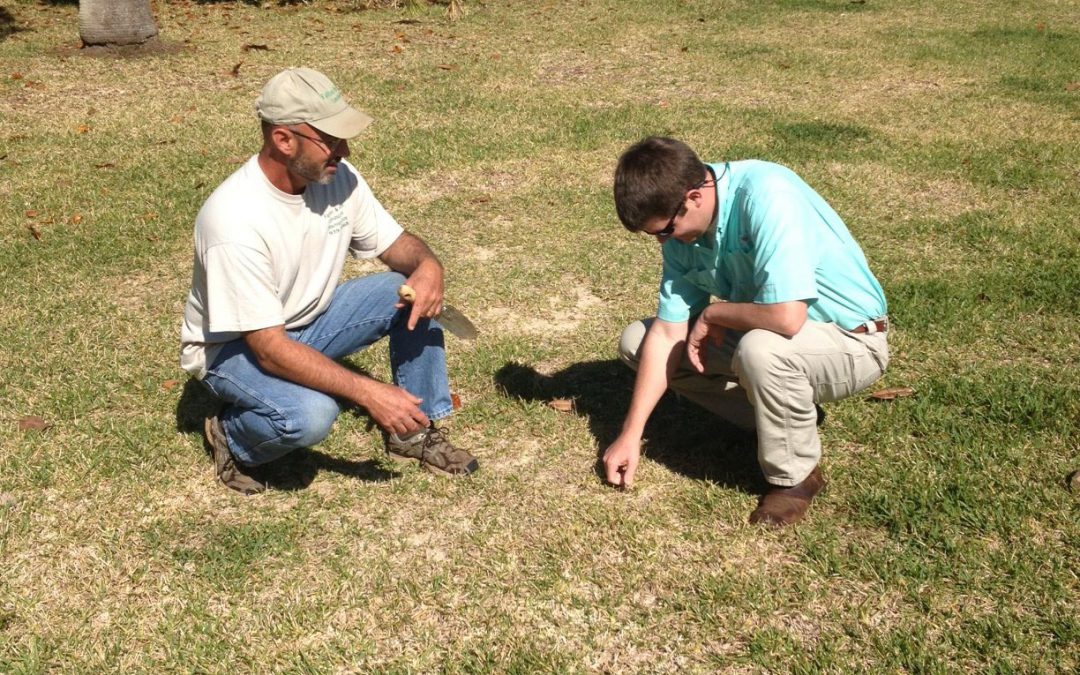
by Blake Thaxton | Mar 24, 2015
Some times the lawn just gets away from us. It can be completely invaded by weeds or have a devastating disease or insect pest cause total destruction. If your lawn is problem prone there are many cultural practices that can be modified to ensure a successful lawn, but sometimes the lawn is in need of a fresh start and needs to be completely reestablished. If over 50% of the lawn is undesirable than it is time to take action to develop better lawn.
What are the factors that may have caused your lawn to decline so badly? Well here are some common problems that may need to be overcome as you move your lawn into its new era:
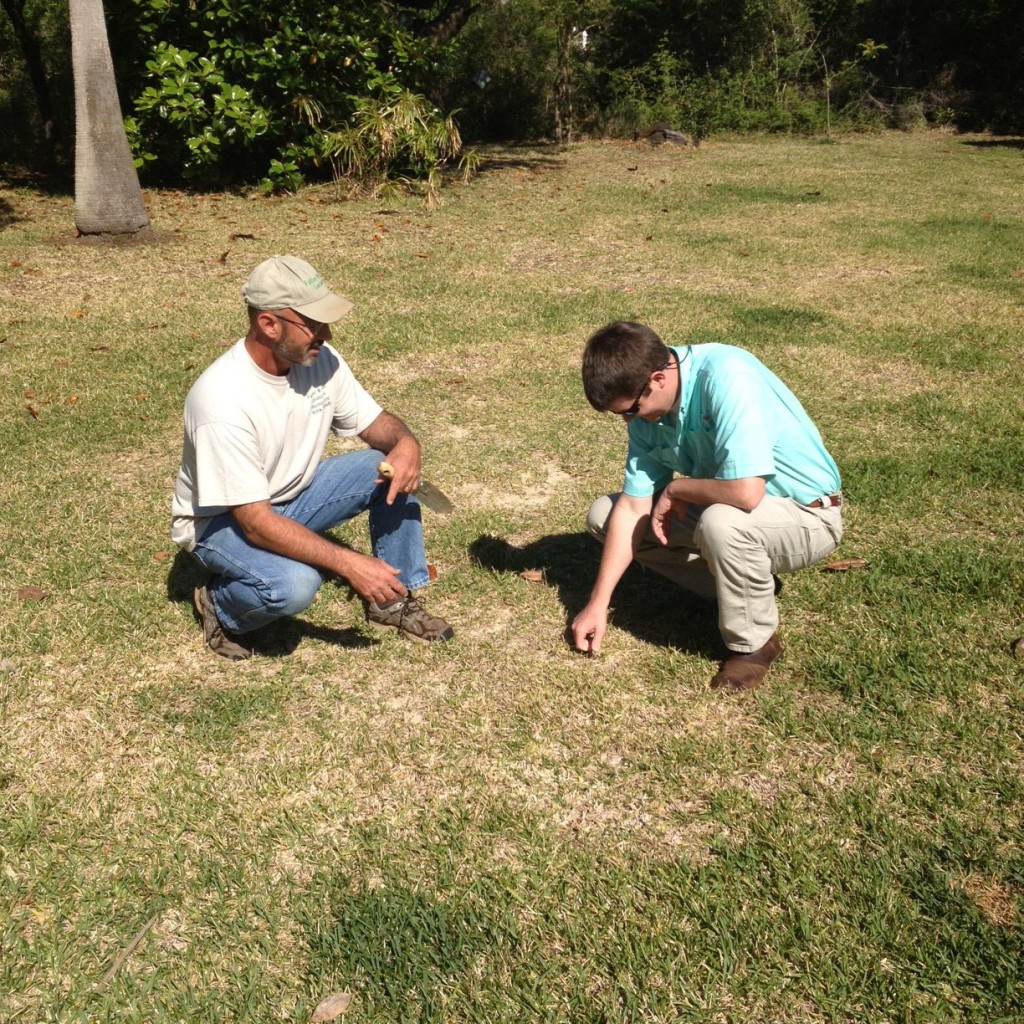
Contact your local UF/IFAS Extension Agent for lawn recommendations, Photo Credit: Blake Thaxton
As a new lawn is established, correcting these problems will help to ensure the investment will be better taken care of in the future.
Which turf should I choose for my next lawn? Try to answer these questions before you decide:
- How much maintenance can I provide?
- What do I expect aesthetically?
- Are there any site limitations ?
Here is a publication from Alabama Cooperative Extension to help you choose the correct turfgrass for your next lawn: Selecting Turfgrasses for Home Lawns (while looking at the tables use the South adaptation for the Florida panhandle)
Once the turfgrass type has been chosen, a variety must be chosen. Here are some recommendations:
- Centipede – ‘Common’
- Zoysia – ‘Empire’, ‘UltimateFlora’, ‘El Toro’
- St. Augustine – ‘Palmetto’, ‘Classic’
Get more information on Lawn Management in the Florida Lawn Handbook
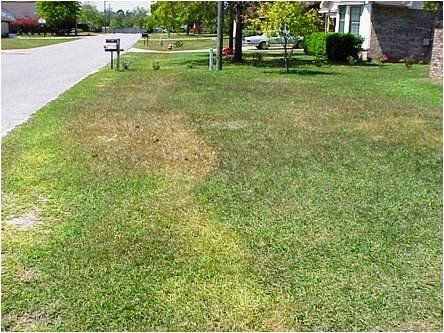
by Larry Williams | Mar 17, 2015
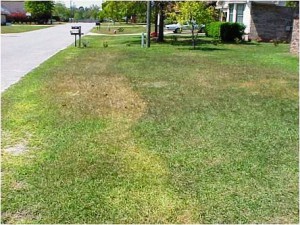
Cold injury to lawn from too early fertilizer application. Credit: Larry Williams
It’s too early to fertilize our warm-season lawn grasses now. This includes the use of fertilizers contained in weed-and-feed products.
There are a number of reasons why it’s best to wait to fertilize your lawn.
First, the soil temperature is too cool for grass roots to have access to some of the fertilizer elements. For example, iron and potassium are poorly available until the soil warms up in spring. Some nutrients leach below the grass roots because the lawn can’t use them yet. This results in waste of fertilizer, time and money.
Secondly, fertilizing too soon can induce nutrient deficiencies and off color areas in your lawn. This is one cause for bright yellow areas in lawns during early spring. Nitrogen is readily taken up by the lawn, even under cool soil conditions, and stimulates early green growth. Early lawn growth is dependent on iron also being readily available. However, iron is poorly available under the cool soil conditions of late winter and early spring. Therefore lawns turn yellow in areas due to an iron deficiency caused by an early fertilizer application. Many times, as soil temperatures warm during mid April and May, the iron becomes available and the lawn turns green. So why not avoid this scenario by waiting until mid April to fertilize your lawn?
It takes consistently warm night temperatures to allow the soil to become warm enough for best root growth and optimal uptake of fertilizer.
Thirdly, the young, tender grass roots that are beginning to grow in early spring are easily burned by the fertilizer.
Fourthly, fertilizing too early can stimulate early lawn growth, which is tender and easily injured by a late frost. The average date for our last killing frost is mid March.
Also, be very cautious about using weed-and-feed products that recommend a late winter application. These products are usually high in nitrogen, which will cause your lawn to begin growing too early. If you’re trying to control weeds, it’s best to apply your herbicides separately from fertilizer, anyway.
In North Florida, it’s best to wait until your lawn has completely greened up in spring before applying any fertilizer.
Waiting allows for more efficient use of the fertilizer. You will not injury you lawn by waiting to fertilize but you can certainly injure your lawn by fertilizing too early.
So, have patience, allow your lawn to green up on its own and then fertilize, even if it’s not until mid April or May.
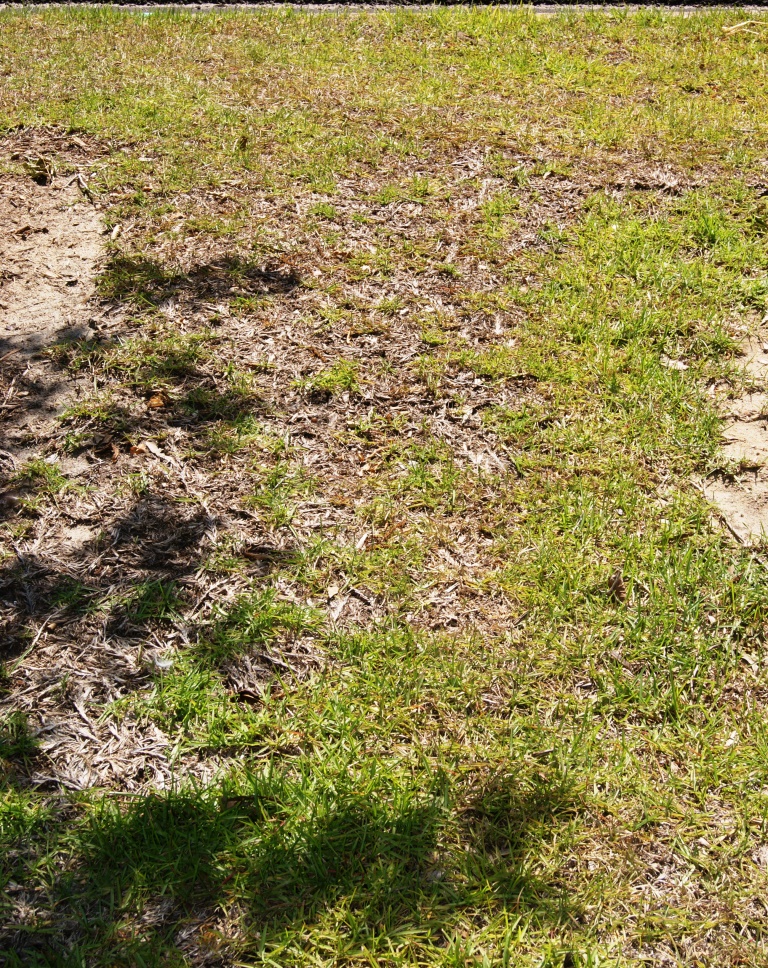
by Larry Williams | Feb 17, 2015
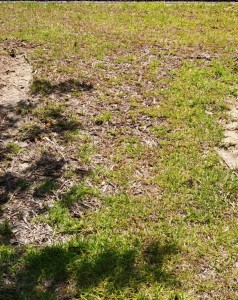
Diseased Turfgrass – Image Credit Matthew Orwat
With a few nice late winter days, many people get a good dose of spring fever. But be careful when the fever hits you. Don’t fertilize your lawn too early. The fever may turn into a lawn “headache”.
Wait to fertilize. Fertilizing while the soil is too cool can result in nutrient deficiencies such as iron deficiency causing yellow areas in the lawn. Fertilizing early can result in injury to a lawn’s roots from fertilizer burn. Or tender growth promoted by an early fertilizer application may be injured by a late frost or freeze. Have patience, allow the lawn to green up on its own and then fertilize, even if it’s not until mid April or May.
Get the numbers right. Our lawns need almost the same amount of potassium as compared to nitrogen. Getting this right can make a difference in the long-term health of your lawn. Look for a lawn fertilizer with an analysis such as 8-0-8, 10-0-10, 15-0-15, 18-0-18, 15-2-15, 16-0-8, etc. Look for a fertilizer with a 1:1 ratio of nitrogen to potassium. These numbers provide the buyer important information. The first number is the percent nitrogen (N), the second number is the percent phosphorus (P) and the third number is the percent potassium (K). Adequate potassium has been linked to reduced disease problems, drought and cold tolerance and enhanced root growth.
Use low phosphorus. Lawn grasses use much less phosphorus than nitrogen or potassium. Because of this and because phosphorus has been implicated as a cause for problems in our surface waters, it’s recommended to base phosphorus rates on the results of a reliable soil test. In absence of soil test results, select a fertilizer with 2% or less phosphorus such as 15-2-15, 8-0-8, 16-0-8, etc. It’s best to base P applications on the results of a reliable soil test.
Don’t fertilize too late. The latest month to fertilize our warm season lawn grasses in North Florida as recommended by University of Florida turfgrass researchers is mid September. If you have centipedegrass, it’s recommended to fertilize no later than July.
Measure your lawn. Most homeowners apply too much fertilizer because they do not know the square footage of their lawn. Measure the size of your lawn (front, back and side yard) and err on the side of using less fertilizer than recommended.
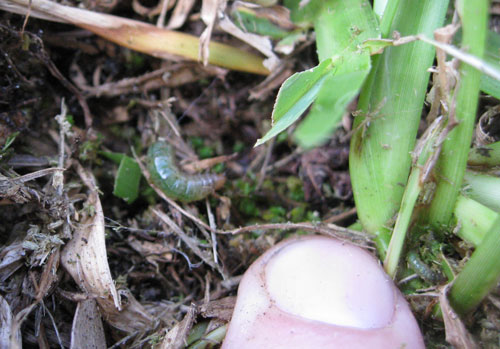
by Taylor Vandiver | Sep 9, 2014
What’s eating my lawn? Does your grass look ragged in areas, as if someone randomly used a weed-eater here and there? Are you noticing brown patches that have a closely clipped appearance compared to other areas of your lawn? Your turf may be playing host to Tropical Sod Webworm.
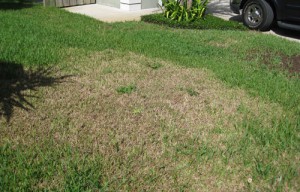
Sod webworm damage in a home lawn. Photo courtesy UF/IFAS.
Sod webworm damage is subtle at first. You have to look closely to notice larval feeding damage. However, an easy indication of their presence is the light tan/brown colored moths, which are the adult stage of the pest. You may see them fly up as you walk through your lawn or if you disturb a nearby bush. The moths do not cause any damage to the turf, but they are depositing eggs, which will result in their offspring, the caterpillars, who do all the chewing damage.
The larvae are gray-green and have spots on each segment. The mature larvae can be up to 1 inch in length. Larvae will curl up in the soil during the day and feed at night. So if you happen to notice caterpillars feeding during the day, it’s probably not sod webworm. You will notice chewed notches along the leaf blade, holes in the leaf and even leaf blade skeletonizing. The older the larvae are, the more they will eat. Damage may start out as a ragged appearance in your turf, which can be hard to diagnose. However, if left unchecked, sod webworm can cause considerable injury to your lawn.
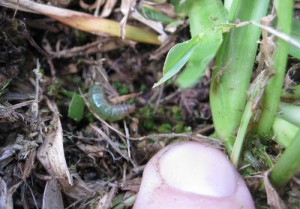
Sod webworm larvae. Photo courtesy UF/IFAS.
If you are uncertain of their presence you can always use a soap drench to flush out larvae. Mix 2 tablespoons of dish soap with 2 gallons of water and pour it over a damaged area (about 3 square ft.). The soap mixture will irritate the pest and bring them to the surface so you can easily identify them. If nothing appears in the area tested move to another damaged site and try again. Here is a link to a video that will give more information on identifying Tropical Sod Webworm.
Tropical Sod Webworm is considered a pest of all warm-season turfgrasses. However, St. Augustinegrass is most commonly affected. The best way to prevent a pest infestation is to use proper cultural maintenance practices for your lawn type. However, if the pest does appear, chemical control should be targeting the larvae stage of the pest. There are multiple products marketed to control lawn caterpillars. However, you may want to consider using B.t. (Bacillus thurengiensis), which is a bacterium that will only harm caterpillars and not bother beneficial insects that may be in your lawn. For more information you can contact your local extension office.












